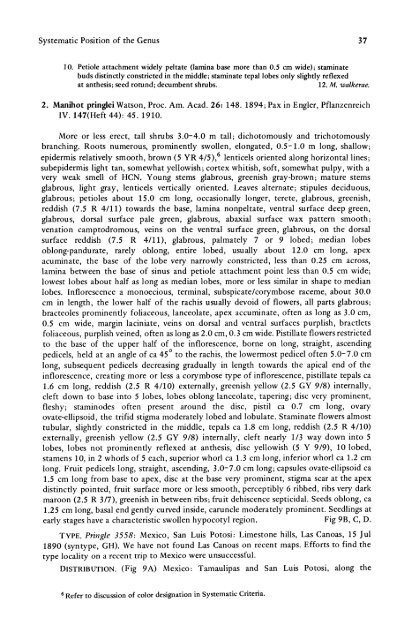Manihot Manihotoides (Euphorbiaceae) - CNCFlora
Manihot Manihotoides (Euphorbiaceae) - CNCFlora
Manihot Manihotoides (Euphorbiaceae) - CNCFlora
You also want an ePaper? Increase the reach of your titles
YUMPU automatically turns print PDFs into web optimized ePapers that Google loves.
Systematic Position of the Genus 37<br />
10. Petiole attachment widely peltate (lamina base more than 0.5 cm wide); staminate<br />
buds distinctly constricted in the middle; staminate tepal lobes only slightly reflexed<br />
at anthesis; seed rotund; decumbent shrubs. 12. M. walkerae.<br />
2. <strong>Manihot</strong> pringlei Watson, Proc. Am. Acad. 26: 148. 1894; Pax in Engler, Pflanzenreich<br />
IV. 147(Heft 44): 45. 1910.<br />
More or less erect, tall shrubs 3.0-4.0 m tall; dichotomously and trichotomously<br />
branching. Roots numerous, prominently swollen, elongated, 0.5-1.0 m long, shallow;<br />
epidermis relatively smooth, brown (5 YR 4/5),6 lenticels oriented along horizontal lines;<br />
subepidermis light tan, somewhat yellowish; cortex whitish, soft, somewhat pulpy, with a<br />
very weak smell of HCN. Young stems glabrous, greenish gray-brown; mature stems<br />
glabrous, light gray, lenticels vertically oriented. Leaves alternate; stipules deciduous,<br />
glabrous; petioles about 15.0 cm long, occasionally longer, terete, glabrous, greenish,<br />
reddish (7.5 R 4/11) towards the base, lamina nonpeltate, ventral surface deep green,<br />
glabrous, dorsal surface pale green, glabrous, abaxial surface wax pattern smooth;<br />
venation camptodromous, veins on the ventral surface green, glabrous, on the dorsal<br />
surface reddish (7.5 R 4/11), glabrous, palmately 7 or 9 lobed; median lobes<br />
oblong-pandurate, rarely oblong, entire lobed, usually about 12.0 cm long, apex<br />
acuminate, the base of the lobe very narrowly constricted, less than 0.25 cm across,<br />
lamina between the base of sinus and petiole attachment point less than 0.5 cm wide;<br />
lowest lobes about half as long as median lobes, more or less similar in shape to median<br />
lobes. Inflorescence a monoecious, terminal, subspicate/corymbose raceme, about 30.0<br />
cm in length, the lower half of the rachis usually devoid of flowers, all parts glabrous;<br />
bracteoles prominently foliaceous, lanceolate, apex accuminate, often as long as 3.0 cm,<br />
0.5 cm wide, margin laciniate, veins on dorsal and ventral surfaces purplish, bractlets<br />
foliaceous, purplish veined, often as long as 2.0 cm, 0.3 cm wide. Pistillate flowers restricted<br />
to the base of the upper half of the inflorescence, borne on long, straight, ascending<br />
pedicels, held at an angle of ca 45? to the rachis, the lowermost pedicel often 5.0-7.0 cm<br />
long, subsequent pedicels decreasing gradually in length towards the apical end of the<br />
inflorescence, creating more or less a corymbose type of inflorescence, pistillate tepals ca<br />
1.6 cm long, reddish (2.5 R 4/10) externally, greenish yellow (2.5 GY 9/8) internally,<br />
cleft down to base into 5 lobes, lobes oblong lanceolate, tapering; disc very prominent,<br />
fleshy; staminodes often present around the disc, pistil ca 0.7 cm long, ovary<br />
ovate-ellipsoid, the trifid stigma moderately lobed and lobulate. Staminate flowers almost<br />
tubular, slightly constricted in the middle, tepals ca 1.8 cm long, reddish (2.5 R 4/10)<br />
externally, greenish yellow (2.5 GY 9/8) internally, cleft nearly 1/3 way down into 5<br />
lobes, lobes not prominently reflexed at anthesis, disc yellowish (5 Y 9/9), 10 lobed,<br />
stamens 10, in 2 whorls of 5 each, superior whorl ca 1.3 cm long, inferior whorl ca 1.2 cm<br />
long. Fruit pedicels long, straight, ascending, 3.0-7.0 cm long; capsules ovate-ellipsoid ca<br />
1.5 cm long from base to apex, disc at the base very prominent, stigma scar at the apex<br />
distinctly pointed, fruit surface more or less smooth, perceptibly 6 ribbed, ribs very dark<br />
maroon (2.5 R 3/7), greenish in between ribs; fruit dehiscence septicidal. Seeds oblong, ca<br />
1.25 cm long, basal end gently curved inside, caruncle moderately prominent. Seedlings at<br />
early stages have a characteristic swollen hypocotyl region. Fig 9B, C, D.<br />
TYPE. Pringle 3558: Mexico, San Luis Potosi: Limestone hills, Las Canoas, 15 Jul<br />
1890 (syntype, GH). We have not found Las Canoas on recent maps. Efforts to find the<br />
type locality on a recent trip to Mexico were unsuccessful.<br />
DISTRIBUTION. (Fig 9A) Mexico: Tamaulipas and San Luis Potosi, along the<br />
6 Refer to discussion of color designation in Systematic Criteria.

















